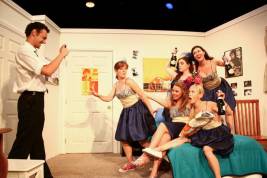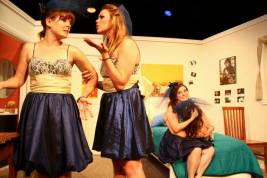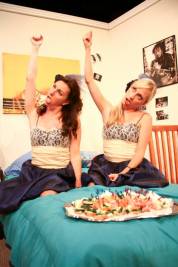NOT RECOMMENDED
Five Women Wearing The Same dress spend a couple of hours doing what women often do; they talk—about men, about life, about love, about relationships, about sex, in Alan Ball’s Five Women Wearing The Same Dress, now playing in Hollywood’s Theater Row at the Ruby. Not much happens during the course of the play’s two acts. Marriages and relationships don’t come apart, though one of the latter does start to blossom. No great new friendships are forged, nor do any fall to pieces. Sort of like real life, when you come to think of it.
The Five Women are, as might be expected, bridesmaids, whom Ball has gathering in the bride’s sister’s upstairs bedroom as the wedding reception goes on full swing in the yard below. Frances (Nicole-Marie Ferguson) is a sheltered young innocent whose conversation is peppered by sayings like “No ma’am. I do not take drugs. I’m a Christian.” Meredith (Laura Hartley) is the bride’s tomboy kid sister, whose apparent forthrightness hides a dark secret. Friend-of-the-bride Trisha (Amanda Samoyloff) is the bad girl of the group, and the only one who’s slept with anywhere near a hundred men. Georgeanne (Megan Blakeley) is an old friend of Tracy’s whose marriage is on the rocks, but who takes her wedding day champagne straight from the bottle. Mindy (Tamara Davis) is the groom’s older sister, and the one whose lesbian partner of nine years was conspicuously not invited to the wedding. Then there’s Tripp Davenport (Justin Lawrence Barnes), an usher who pops up late in Act Two to add a bit of testosterone to the proceedings.
Playwright Ball, whose many credits include the Oscar-winning American Beauty and the Emmy-winning Six Feet Under, is known for his somewhat off-center look at life, love, and the American way. Though his characters are more than a tad quirky, he nonetheless creates people who remain rooted in a reality we can all recognize. Unfortunately, by losing sight of the fact that the five young title characters are real women, and not merely characters to be played for laughs, theTribe Production’s staging of Five Women Wearing The Same Dress ends up less successful at conveying this reality than Ball’s film and TV work has been.
Under Christopher Chase’s heartfelt direction, each of the Five Women Wearing The Same Dress has her good, effective moments and each one gets laughs aplenty. Still, this reviewer couldn’t help thinking how much richer and realer Five Women Wearing The Same Dress would be if most performances at the Ruby were taken down two or three notches, and if the laughs came naturally and not as a result of playing for laughs.
The six actors have a terrific script to work with, and Ball’s writing goes a long way towards making theTribe’s production as funny as it is. Hartley’s performance is the most grounded in reality, and is therefore the most successful, and believable—particularly in Meredith’s shocking revelations, and her even more shocking nonchalance about them. Samoyloff too has some excellent moments, most notably in her extended flirtation scene opposite Barnes (very good as Tripp), effective because they are among the production’s realest. Ferguson is often a delight as babe-in-the-woods Frances, but a bit more underplaying would make her performance more believable. I liked Davis’s work as feisty Mindy. Finally, there’s Blakeley’s Georgeanne, whose drunkenness is played way over the top—an actress “acting drunk” and not a drunken woman trying hard to maintain a semblance of normal conversation despite being three sheets to the wind. Blakely does get laughs from some inventively choreographed drunken moves, but they come across as deliberately planned rather than the real thing. The same can be said for some comic business between Frances and Mindy (not in Ball’s script, by the way) that despite the laughter it provokes, comes across planned in advance.
A glance at the published version of Ball’s play reveals that it is supposed to be set in Knoxville, Tennessee, and that too may be a reason why things don’t click the way they should. Try to imagine Steel Magnolias or Crimes Of The Heart played with Yankee accents and those quirky Southern belles might not seem nearly so real. The same may be true with Ball’s Knoxville Five.
Scenic designer Robert Lofstrom’s bedroom set is one of the best I’ve seen at the Ruby, realistic and well-detailed. Costume designer Jeannine Campi has come up with precisely the kind of god-awful dresses that bridesmaids would rather be seen dead than wear. There is no credited lighting or sound designer. Lighting is simple but does the job, with the exception of a light outside the bedroom window which stays on even during blackouts, making for some awkward “places everyone” entrances and “time to get offstage” exits that ought not to be seen by the audience. Any sort of sound design is pretty much non-existent, and attentive theatergoers may notice the lack of party noises or music wafting in from outside. Finally, the cast enthusiastically applaud each other’s performances at curtain calls, something you’ll likely not see in a major professional production. These are the sort of not-so-minor details that separate the best of 99-seat theater in Los Angeles from the hundreds of productions that end up under the radar of most reviewers and playgoers.
Still, though Chase’s current directorial effort is not yet anywhere near the “Broadway quality” theTribe aims for in its mission statement, the young Cal State Northridge grad’s work here shows promise, drive, and a passion for the art of live theater, and as one of the founders of theTribe, he and theTribe’s lofty goals are to be saluted and encouraged. As it stands now, Five Women Wearing The Same Dress kept me laughing, but it could have done more.
The Ruby Theatre (at THE COMPLEX), 6476 Santa Monica Blvd., Hollywood.
www.theTRIBEproductions.org
–Steven Stanley
September 10, 2010





 Since 2007, Steven Stanley's StageSceneLA.com has spotlighted the best in Southern California theater via reviews, interviews, and its annual StageSceneLA Scenies.
Since 2007, Steven Stanley's StageSceneLA.com has spotlighted the best in Southern California theater via reviews, interviews, and its annual StageSceneLA Scenies.







 COPYRIGHT 2024 STEVEN STANLEY :: DESIGN BY
COPYRIGHT 2024 STEVEN STANLEY :: DESIGN BY